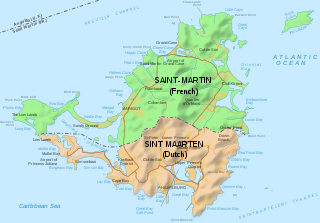
Saint Martin is an island in Leeward Islands of the Lesser Antilles in the northeastern Caribbean, approximately 300 km (190 mi) east of Puerto Rico. The 87 km2 (34 sq mi) island is divided roughly 60:40 between the French Republic and the Kingdom of the Netherlands, but the Dutch part is more populated than the French. Divided since 1648, the northern French part comprises the Collectivity of Saint Martin and is an overseas collectivity of the French Republic. The southern Dutch part comprises Sint Maarten and is one of four constituent countries that form the Kingdom of the Netherlands. Even though the island is an overseas possession of two European Union member states, only the French part of the island is part of the EU.
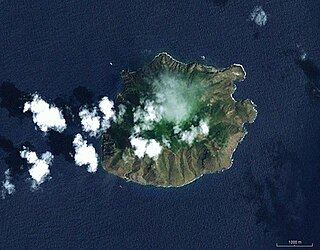
Saba is a Caribbean island and the smallest special municipality of the Netherlands. It consists largely of the dormant volcano Mount Scenery, which at 887 metres (2,910 ft) is the highest point of the entire Kingdom of the Netherlands. The island lies in the northern Leeward Islands portion of the West Indies, southeast of the Virgin Islands. Together with Bonaire and Sint Eustatius it forms the BES islands, also known as the Caribbean Netherlands.

Princess Juliana International Airport is the main airport on the Caribbean island of Saint Martin. The airport is located on the Dutch side of the island, in the country of Sint Maarten, close to the shore of Simpson Bay Lagoon. In 2015, the airport handled 1,829,543 passengers and around 60,000 aircraft movements. The airport serves as a hub for Winair and is the major gateway for the smaller Leeward Islands, including Anguilla, Saba, Saint Barthélemy and Sint Eustatius. It is named after Queen Juliana of the Netherlands, who landed there while she was heir presumptive in 1944, the year after the airport opened. The airport has very low-altitude flyover landing approaches because one end of its runway is extremely close to the shore and Maho Beach. While Princess Juliana International is the primary aviation gateway to the island, there is also a smaller public-use airport on the French side, in the French Collectivity of Saint Martin, called Grand Case-Espérance Airport.

"O Sweet Saint Martin's Land", also known by its French title, "Saint-Martin, si jolie", is the bi-national song of Saint-Martin / Sint Maarten island, an island divided between the French Republic and the Kingdom of the Netherlands. It was written in English by Gerard Kemps in 1958. Kemps also wrote and composed a French version with its own lyrics and a different tune.
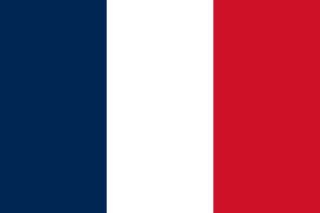
The Collectivity of Saint Martin, commonly known as simply Saint Martin, is an overseas collectivity of France in the West Indies in the Caribbean, on the northern half of the island of Saint Martin, as well as some smaller adjacent islands. Saint Martin is separated from the island of Anguilla by the Anguilla Channel. Its capital is Marigot.

Sint Maarten is a constituent country of the Kingdom of the Netherlands located in the Caribbean region of North America. With a population of 58,477 as of June 2023 on an area of 34 km2 (13 sq mi), it encompasses the southern 44% of the divided island of Saint Martin, while the northern 56% of the island constitutes the French overseas collectivity of Saint Martin. Sint Maarten's capital is Philipsburg. Collectively, Sint Maarten and the other Dutch islands in the Caribbean are often called the Dutch Caribbean.
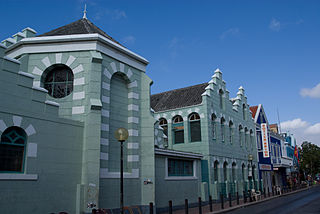
The Roman Catholic Diocese of Willemstad is a diocese of the Latin Church of the Roman Catholic Church in the Caribbean. The diocese encompasses the territory of the Kingdom of the Netherlands in the Caribbean: the countries Aruba, Curaçao, Sint Maarten and the islands Bonaire, St. Eustatius, Saba. The cathedra is in the city of Curaçao. The diocese is a suffragan of the Archdiocese of Port of Spain, and a member of the Antilles Episcopal Conference.

The Catholic Church in the Caribbean part of the Kingdom of the Netherlands is part of the worldwide Roman Catholic Church, under the spiritual leadership of the Pope in Rome.

Simpson Bay Lagoon is one of the largest inland lagoons in the West Indies of the Caribbean. It is located on the island of Saint Martin. The border between the French and Dutch halves of the island runs across the centre of the lagoon. There are two small islands that lie in the lagoon: the larger, Grand Ilet to the north, is within the French region of Saint-Martin; the smaller, Little Key, to the south, is on the Dutch Sint Maarten side.

The following outline is provided as an overview of and topical guide to the Collectivity of Saint Martin:

Sint Maarten, a constituent country of the Kingdom of the Netherlands, has a government formed by the monarch, represented by the governor, and the ministers. The Prime Minister of Sint Maarten presides over the council of ministers. Executive power is exercised by the government. Legislative power is vested in both the government and parliament. The minister plenipotentiary is not part of the government and represents the Sint Maarten government in the Netherlands. The judiciary is independent of the executive and the legislature. The country is a parliamentary representative democratic country with a multi-party system. Sint Maarten has full autonomy on most matters, with the exceptions summed up in the Charter for the Kingdom of the Netherlands under the title "Kingdom affairs". The Constitution of Sint Maarten was ratified in September 2010, and entered into force on 10 October 2010.

The economy of Saint Martin, divided between the French Collectivity of Saint Martin and the Dutch Sint Maarten, is predominately dependent on tourism. For more than two centuries, the main commodity exports have generally been salt and locally grown commodities, like sugar.

Lesbian, gay, bisexual, and transgender (LGBT) people in Sint Maarten may face legal challenges not experienced by non-LGBTQ residents. Both male and female same-sex sexual activity are legal in Sint Maarten, a constituent country of the Kingdom of the Netherlands, but same-sex marriage is not legal. Same-sex couples with Dutch nationality must travel to the Netherlands to get married, and that will not provide the rights of marriage in Sint Maarten.

The Sacred Heart Church is a religious building belonging to the Catholic Church and is located in the town of The Bottom, capital of the Caribbean island of Saba a dependent territory that has the status of special municipality of the Kingdom of the Netherlands in the Caribbean Sea or sea of the Antilles.

The Holy Rosary Church, also known as the Queen of the Holy Rosary Church, is a religious building affiliated with the Catholic church in the small town of Hell's Gate on the island of Saba, a dependent territory of the Kingdom of the Netherlands in the Lesser Antilles, Caribbean Sea.

The St. Martin of Tours' Church is a religious building is located at 51 Voorstraat, Voorstraat, in the city of Philipsburg, Sint Maarten on the Dutch side of the Caribbean island of St. Martin in the Lesser Antilles east of the Caribbean Sea or Sea The Antilles.
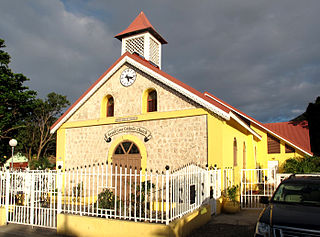
Mary Star of the Sea Church or Grand Case Catholic Church is a religious building affiliated to the Catholic Church located in Grand Case in the territorial collectivity of Saint Martin, a dependent territory of France that consists of the north half of the island of Saint Martin in the lesser Antilles. It should not be confused with the catholic church of the same name but located in the Dutch sector of the island.

The COVID-19 pandemic in Sint Maarten, also known as the coronavirus disease 2019 pandemic in Sint Maarten, was a part of the ongoing viral pandemic of coronavirus disease 2019 (COVID-19), which was confirmed to have reached the Dutch Caribbean island of Sint Maarten on 17 March 2020. By 15 June, all cases recovered. On 1 July, a new case had been discovered, which resolved on 3 July On 15 July, a 79th case was discovered.
The history of the Jews in Sint Maarten started before 1735, when two Jewish families already lived in Sint Maarten, most likely descendants of refugees that fled the Spanish Inquisition. A Jewish congregation existed by the 1780s. This community operated a synagogue that was located in Philipsburg, between Front Street and Back Street. After Hurricane San Mateo hit Sint Maarten on September 21, 1819, the synagogue was destroyed and the island's Jewish community dwindled. Remnants of the synagogue can still be found behind what is now the Guavaberry Emperium on Front Street. Whether a Jewish cemetery existed in Philipsburg is debated. In the early 1850s, only 3 Jews lived in Sint Maarten. This was only 0.1% of the total population. Eventually, all Jews left the island.

The Saint Martin–Sint Maarten border, or France–Netherlands border, is the border between the Collectivity of Saint Martin, an overseas collectivity of France, and Sint Maarten, a constituent country of the Kingdom of the Netherlands, on the island of Saint Martin in the Caribbean. The 87-square-kilometre (34 sq mi) island is divided roughly 60:40 between the French Republic and the Kingdom of the Netherlands by the 16 km (10 mi) border. However, the two parts are roughly equal in population.


















